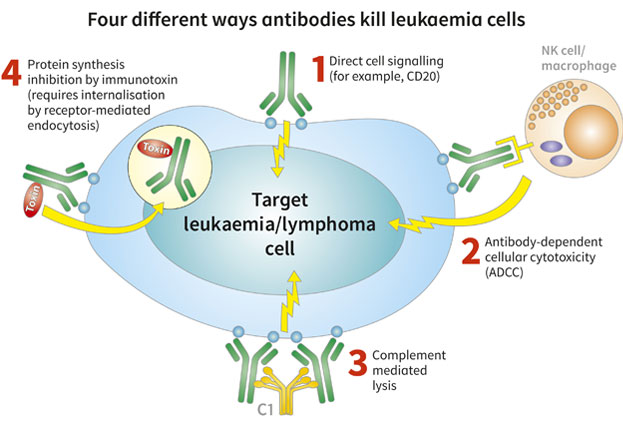
How antibodies can be used to kill leukaemia cells
Understanding the way in which antibodies kill leukaemia and lymphoma cells is very important and enables us to design better antibody-based drugs that will allow us to maximize their therapeutic benefits for patients.
This diagram shows four different ways in which antibody-based drugs can kill target leukaemia and lymphoma cells.
-
1. Some antibodies can kill their target cell by simply attaching to the antigen they recognize. This causes a “killer signal” to be sent into the cells interior instructing it to commit suicide through a process known as apoptosis or programmed cell death. Such an example of this is the anti-CD20 antibody rituximab that is now in regular clinical use for the treatment of patients with certain types of lymphoma and chronic lymphocytic leukaemia (CLL). By combining rituximab antibody treatment with conventional chemotherapy (so called immunochemotherapy) better results and outcomes have been obtained for patients. Leukaemia Busters scientists have shown that by using two antibody-based drugs, rituximab and BU12-SAPORIN in combination, the therapeutic effect is significantly enhanced compared with when each is used alone.
-
2. Antibodies can work in conjunction with the body’s own immune cells to kill the target as in antibody-dependent cellular cytotoxicity or ADCC for short. Here the antibody already attached to the surface of the target leukaemia cell attracts natural killer or NK cells from the bloodstream of the patient which then attach to the tail portion of the antibody via a special receptor on their surface. This causes the NK cells to release granules containing killer molecules called granzymes that penetrate into the target leukaemia cell killing it. Leukaemia Buster scientists have shown that their own immunotoxins antibody-based drugs, HB2-SAPORIN works together with ADCC to give a significantly improved therapeutic effect.
-
3. Complement is a series of special normal proteins in the bloodstream that assemble into a complex that punches holes through the membrane of the cell usually when an antibody binds to an antigen on the cell surface. This is a normal defence mechanism used by our immune system to protect us against bacterial and other microorganisms.
-
4. An antibody can be “armed” with a powerful toxin, drug or radioisotope which is then delivered directly to the cancer cell by the antibody. Leukaemia Busters scientists have chosen to arm antibodies with the toxin saporin to create a hybrid molecule called an immunotoxin. In order for this particular approach to work it is essential that the toxin is taken up by the target cancer cell and we are exploring ways of making this process more efficient thus increasing the potency of the immunotoxin.

